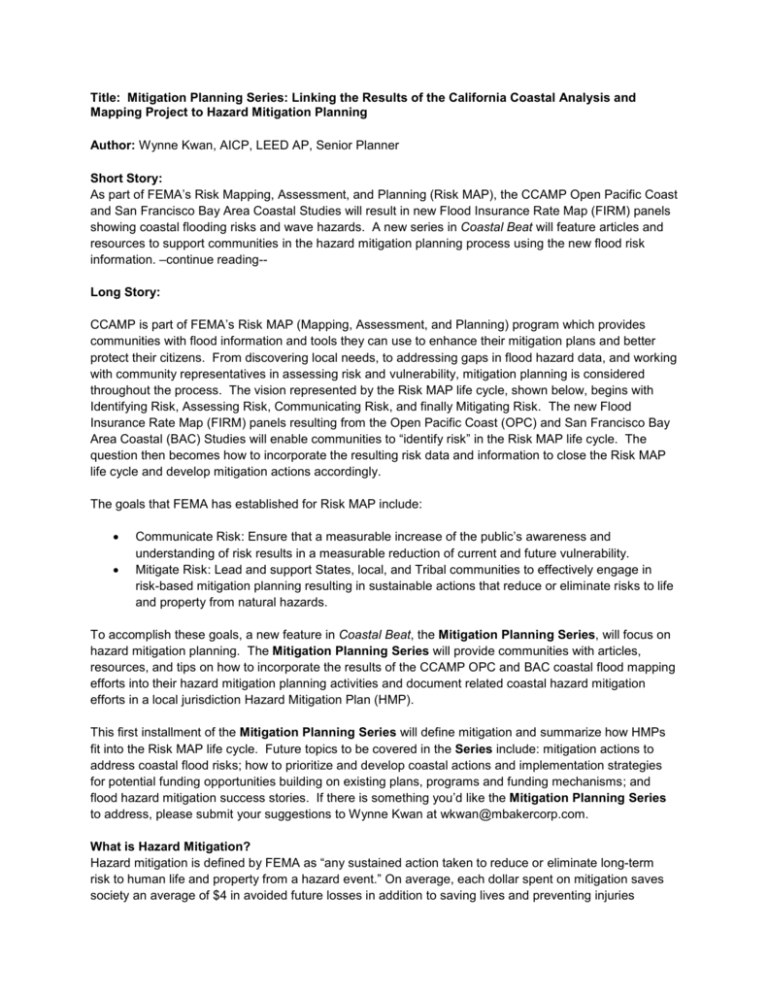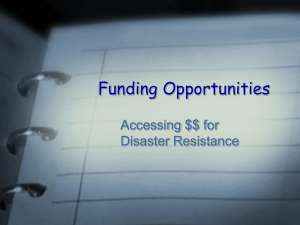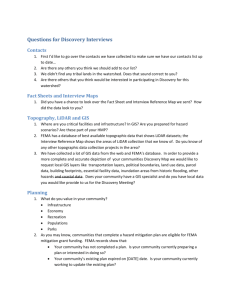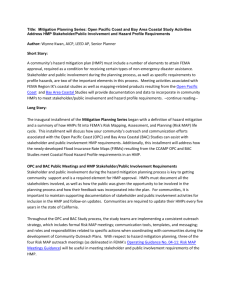Mitigation Series-FINAL_Issue 2_Article 3
advertisement

Title: Mitigation Planning Series: Linking the Results of the California Coastal Analysis and Mapping Project to Hazard Mitigation Planning Author: Wynne Kwan, AICP, LEED AP, Senior Planner Short Story: As part of FEMA’s Risk Mapping, Assessment, and Planning (Risk MAP), the CCAMP Open Pacific Coast and San Francisco Bay Area Coastal Studies will result in new Flood Insurance Rate Map (FIRM) panels showing coastal flooding risks and wave hazards. A new series in Coastal Beat will feature articles and resources to support communities in the hazard mitigation planning process using the new flood risk information. –continue reading-Long Story: CCAMP is part of FEMA’s Risk MAP (Mapping, Assessment, and Planning) program which provides communities with flood information and tools they can use to enhance their mitigation plans and better protect their citizens. From discovering local needs, to addressing gaps in flood hazard data, and working with community representatives in assessing risk and vulnerability, mitigation planning is considered throughout the process. The vision represented by the Risk MAP life cycle, shown below, begins with Identifying Risk, Assessing Risk, Communicating Risk, and finally Mitigating Risk. The new Flood Insurance Rate Map (FIRM) panels resulting from the Open Pacific Coast (OPC) and San Francisco Bay Area Coastal (BAC) Studies will enable communities to “identify risk” in the Risk MAP life cycle. The question then becomes how to incorporate the resulting risk data and information to close the Risk MAP life cycle and develop mitigation actions accordingly. The goals that FEMA has established for Risk MAP include: Communicate Risk: Ensure that a measurable increase of the public’s awareness and understanding of risk results in a measurable reduction of current and future vulnerability. Mitigate Risk: Lead and support States, local, and Tribal communities to effectively engage in risk-based mitigation planning resulting in sustainable actions that reduce or eliminate risks to life and property from natural hazards. To accomplish these goals, a new feature in Coastal Beat, the Mitigation Planning Series, will focus on hazard mitigation planning. The Mitigation Planning Series will provide communities with articles, resources, and tips on how to incorporate the results of the CCAMP OPC and BAC coastal flood mapping efforts into their hazard mitigation planning activities and document related coastal hazard mitigation efforts in a local jurisdiction Hazard Mitigation Plan (HMP). This first installment of the Mitigation Planning Series will define mitigation and summarize how HMPs fit into the Risk MAP life cycle. Future topics to be covered in the Series include: mitigation actions to address coastal flood risks; how to prioritize and develop coastal actions and implementation strategies for potential funding opportunities building on existing plans, programs and funding mechanisms; and flood hazard mitigation success stories. If there is something you’d like the Mitigation Planning Series to address, please submit your suggestions to Wynne Kwan at wkwan@mbakercorp.com. What is Hazard Mitigation? Hazard mitigation is defined by FEMA as “any sustained action taken to reduce or eliminate long-term risk to human life and property from a hazard event.” On average, each dollar spent on mitigation saves society an average of $4 in avoided future losses in addition to saving lives and preventing injuries (National Institute of Building Science Multi-Hazard Mitigation Council 2005). Mitigation can take several forms, including siting, construction techniques, protective works, maintenance, land use regulation, coastal zone management planning, and enhanced natural buffers to address coastal hazards, such as coastal flooding, wave run up, shoreline erosion, and storm surges. The Mitigation Planning Series will highlight various mitigation actions previously implemented by coastal communities to address these coastal hazards. Hazard Mitigation Plans (HMPs) and the Risk MAP Life Cycle The Risk MAP life cycle complements the process of developing and updating HMPs. A community’s HMP, like other official planning documents, serves as its official statement of hazard identification, vulnerability analysis, risk assessment, and mitigation strategy to assist decision makers in directing available resources. With the public involvement components of Risk MAP, opportunities are provided throughout the planning process to communicate risk to, and obtain feedback from community officials and other stakeholders. When communities continuously monitor, evaluate, update, and implement actions identified in their HMPs, the HMP becomes a living document. FEMA collaborates with the California Emergency Management Agency to approve HMPs making it possible for communities to receive federal mitigation and disaster assistance.







